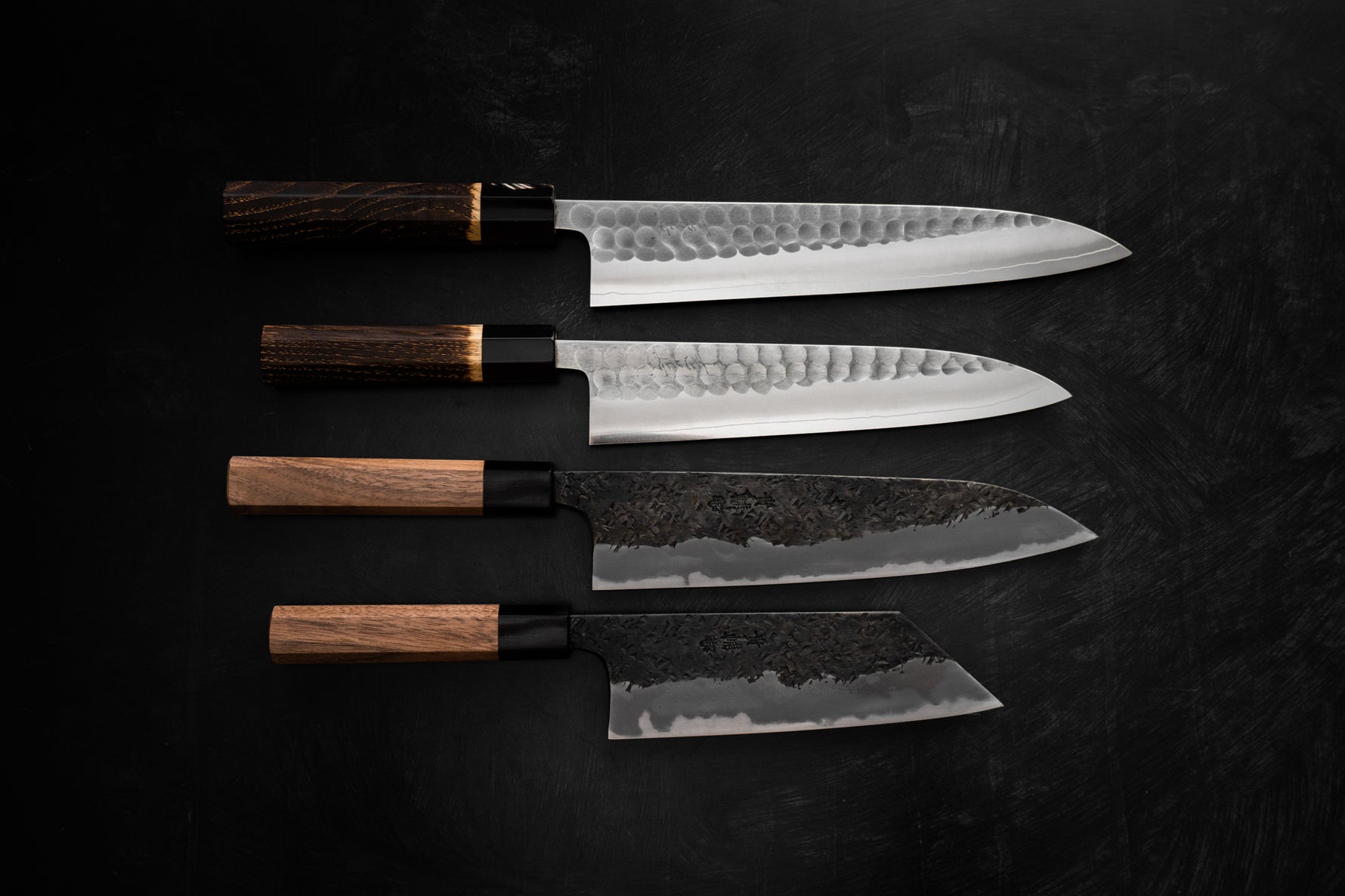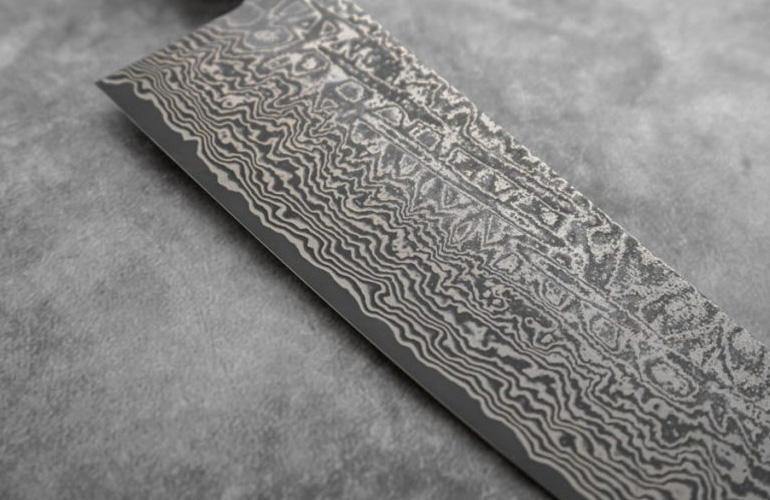Knife Information

Carbon Steel v Stainless Steel. What's Better?
Often a common question among newcomers to Japanese knives is the decision to make between carbon and stainless steel. Which should you choose? There are a few points to consider when making your choice.
The most commonly used Japanese Carbon steels are Aogami (Blue), Shirogami (White). The most commonly used Japanese Stainless steels are VG10, Ginsan, AUS8. The hybrid powder stainless steels with the best of both worlds are SG2/R2, ZDP189, HAP40.
1) Maintenance
This is the key difference between carbon and stainless knives. Carbon steel knives require higher maintenance than stainless steel knives, as they lack chromium content which gives stainless knives their corrosion resistant properties. By definition, a stainless steel is a steel than contain more than 10.5% of chromium.
If you cut produce and leave a carbon steel knife wet on the cutting board, expect rust spots to appear within a matter of minutes. This is not the case for stainless steel. Some carbon steels like Shirogami (White) steel for example, will develop rust quicker than Aogami (Blue) steel, even though they are both carbon steels. This is due to the high purity of Shirogami, and the added elements in Aogami.
As a result of this lack of chromium (which make stainless steel stainless), these knives will also develop what’s called a patina, or a discolouring of the blade due to oxidizing of the steel. This is completely normal, and will produce blueish, purple hues across your blade that cannot be removed short of polishing the blade. Further reading about the patina can be found here.
Once this patina is fully developed, which may take several weeks of use, this will act as a protective barrier from elements which may rust your blade. It is good insurance against leaving your blade wet for a few minutes on the board.
2) Edge retention
On the whole, you will find that carbon steel will retain an edge longer than most stainless steels. Carbon steel has a finer grain structure, and as a result of being forged, the steel will hold an edge for longer than a softer stainless steel.
However, there are exceptions to this point. There exists stainless steels that have more carbon than carbon steel knives, that are also fully stainless. These are referred to as powdered stainless steels, and SG2/R2, ZDP189, and HAP40 are the most prominent of these steels used in knifemaking. These are widely considered to have the best of both worlds, with fantastic edge retention and stainless properties.
3) Ease of sharpening
From our experience, carbon steels will sharpen up easier, faster, and to higher levels than most stainless steels. Shirogami, being the purest carbon steel, will sharpen to a scalpel like edge with ease. Aogami is very similar to sharpen, but will require a small amount of extra effort to reach similar results.
Softer stainless steels like VG10 and AUS8 can be trickier to sharpen than carbon steels, but this also depends on the quality of the heat-treatment of the steel.
The harder powder stainless steels can be the most difficult to sharpen. Due to their high hardness, it is recommended these are sharpened with at least a 500 grit stone to speed up the initial burr forming process.
4) Price
The final point to consider when choosing a carbon or stainless steel japanese knife is the price difference. This price difference will be mainly due to the amount of time required to finish a particular piece, as well as the materials used.
Knives using Shirogami and Aogami carbon steels can be found relatively cheaply, $80-$150) if the process to finish these knives is not very time consuming. Obviously, some knives made using Shirogami or Aogami can be extremely expensive as the time required to finish these pieces to perfection is high.
VG10 is increasing in price and popularity, so it can be difficult to find good, authentic VG10 knives for less than the cost of carbon. Some seemingly reputable knife shops in Australia and the world will source knives made using Chinese “VG10” equivalent, or outright deceive you by saying the steel is from Japan when it is not, and sell these knives cheaply, passing them off as “Japanese”. Beware of these imitations.
The SG2 and powder stainless knives are generally more expensive than the rest of the other steels, starting at around $300 for the Takamura SG2 Gyuto and rising from there. These are often the best quality and value for money out of the stainless steels.
Conclusion
There are many factors that contribute to whether a knife will suit your requirements or not. If you don’t mind some extra care and maintenance, and would prefer to stick to a lower budget, then an entry level carbon steel knife will be your best choice.
If you’d rather spend the extra money and would rather a lower maintenance knife, SG2 or a powder stainless steel will be a great choice you will be sure to love. Just take care around cutting hard objects as to not chip the blade, and you’ll be enjoying your knife for many years.

The use of Damascus Steel in kitchen knives can be somewhat of a polarising topic and poses several questions. Is there any real difference in performance between a Damascus Steel kitchen knife and regular steel kitchen knife? Is it all just for looks? Why are some Damascus kitchen knives so damn expensive and some are so cheap? Here we’ll answer these for you, sticking to the facts and giving you the information you need to make an informed decision about whether a Damascus Steel Kitchen knife may be right for you.
Origins/Types
The term ‘Damascus Steel’ can actually refer to several different types of end product, each utilising different methods and materials. Damascus Steel, Wootz Steel, and Pattern Weld all hold some overlap with each other, but all epitomise a product that is the result of multiple steels that have been forged or cast together using different methodologies then etched to bring out a unique layered finish.
The first iteration of what is referred to as the ‘original’ Damascus Steel in first arose in Middle-Eastern sword making, of which the original technique has been lost for may hundreds of years. This Damascus Steel weaponry was the result of forging Wootz steel, produced in India and traded to the Middle East. Tales of the stunning beauty, strength, and sharpness of the weapons produced spread throughout the world, but the process for making Wootz, the critical component of Damascus Steel, was lost in the 1700’s, and with it, there went the original iteration of Damascus Steel itself. It’s original form has never been replicated, even after the efforts of modern day science.
This presents the argument that any kitchen knife currently available labelled ‘Damascus Steel’ is technically misleading, as all ‘Damascus Steel’ at present time is the result of Pattern Welding several different alloys together which are then forged and re-welded then ‘etched’ with chemicals to produce a Damascus-like pattern. This etching process eats away a particular steel in the blade, leaving the other steel(s) untouched. This process is subject to much experimentation by pattern weld Damascus Steel makers around the world and through arranging the varying steels in specific ways, incredibly complex shapes can be produced on the blade of the knife.
Materials Used
So what is modern day Damascus Steel made from?
The truth is, just about any combination of stainless or alternating high or low carbon steel can be used, in combination with nickel alloys and even in some cases, items like scrap metal, screws, and bolts.
The arrangement of these steels is sketched out and planned as to ascertain the final appearance and then welded together, forged and drawn out, then folded or cut and the process is repeated to attain as many layers as desired.
While these pattern weld Damascus steels are similar in appearance to the first Damascus Steels produced, their internal composition is entirely different.
Some types of modern-day Damascus steel are manufactured by layering stainless steel, resulting in a more subtle pattern. This layered stainless is then ‘clad’ onto a core of harder, more wear-resistant higher carbon steel.
Damascus Steel Kitchen Knives produced using this technique are more expensive, as the time required produces a blade of far superior quality that is durable, but also looks fantastic.
This is a process that has been favoured more and more by Japanese Bladesmiths in recent times due to its fantastic edge retention from the hardness of the inner core, and also the durability due to the layers of more flexible and stain resistant stainless steel on the outside.
Which brings me to the question, “Is Damascus steel better than modern day steel? In terms of strength, and durability, there are modern exotic alloys that can far outperform pattern weld Damascus Steel.
Often, the core cutting edge of a knife is made from high carbon steel and clad with Damascus steel, such as the Yoshimi Kato SG2 Gyuto. It’s core is an exotic alloy, SG2 Powder Steel, and the cladding is alternating layers of stainless steel with added nickel, resulting in the Damascus steel appearance.
But that doesn’t mean that a well made Damascus Steel kitchen knife is of any less use to a professional chef or home cook than a non-Damascus Steel one.
The true appeal of Damascus Steel lies in its unique and exotic patterned finishes, and whether or not they look better than non-Damascus Kitchen knives is entirely subjective.
Just like anything, you get what you pay for. Damascus Steel made the right way requires an extraordinary level of attention to detail, experience, and precision, and it all comes at a price.
If it’s cheap, it ain’t good, and if it’s good, it ain’t cheap.
